NorthEast Radio Watch 12/8/2025: Cichon’s Back in Buffalo
In this week’s issue… Veteran newsman returns - Remembering NY's Leitner, RI's Jones - CT AM saved - Maine AM moves - "Indie" adds suburban signals
Text and photos by SCOTT FYBUSH
I really need to spend more time in South Carolina one of these days. The people are friendly, the driving is easy, there are still corners of the state I’ve never seen, they gave us Stephen Colbert, and the weather is usually really nice, too.
“Usually,” however, didn’t apply in late October 2015, when we had big plans to spend some quality time checking out the Charleston and Myrtle Beach markets at the start of a coastal trip that was going to follow the Radio Show in Atlanta.
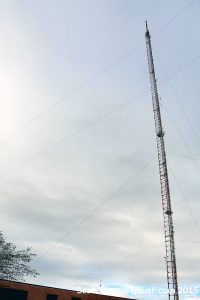
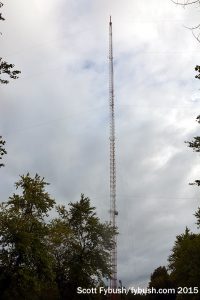
The weather had other ideas, in the form of a massive coastal storm that put a chunk of Charleston underwater as the show was ending. And so instead of a deep dive into South Carolina, we have something more abbreviated for you this week: some quick looks at stations we saw while driving from Raleigh (which we saw in our last installment) to Atlanta (which we’ll see next week), and then on a hurried trip back north to get away from the storm after the show.
But we start this week with some pictures from before the storm rolled in, when all we had to contend with were some low-hanging clouds and intense humidity as we rolled through Florence, South Carolina without a lot of time to spare on the way to Atlanta.
We didn’t get to see much (OK, any) radio on this quick swing through Florence, but we couldn’t resist the lure of two TV towers right off the north side of I-95, just north of Florence itself. There’s still a “News Channel 13” sign in front of the brick building on TV Road that used to house CBS affiliate WBTW, but this is a ghost site now. The dominant station in the Florence-Myrtle Beach market started here with studios and tower back in 1954, moved to a taller tower near Dillon in 1979, and then left these studios a few years ago to relocate to Myrtle Beach, where most of the growth in the market has been.
Just around the corner, there’s a site that’s still active: South Carolina ETV’s WJPM (Channel 33) signed on from this site on Pocket Road, which parallels I-95 to the north, back in 1967. It’s still here, now on RF 45, as one of two SCETV signals serving the market; the other, WHMC in Conway, serves Myrtle Beach on channel 23/RF 9.
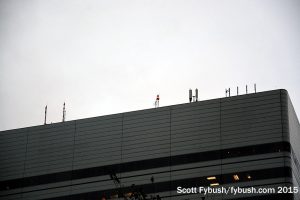
Florence is the eastern end point of I-20, and it’s where we hop off I-95 and make our way westward to Columbia.
Back in 2003, we spent a whole day chasing towers in this market; now we’re here with only an hour or so before sunset, just enough time to park by the statehouse and check out a bit of downtown Columbia scenery.
The market’s dominant TV station, NBC affiliate WIS (Channel 10), is still where we found it last time, in a prominent building at the corner of Bull and Gervais Streets, just up the street from the statehouse that had once again been in the headlines a few months earlier.
A peek up on the roof of a building across Gervais from the statehouse gives us a glimpse of the antennas of WARQ (93.5 Columbia) and WWNQ (94.3 Forest Acres), as well as auxiliary sites for several other Columbia-market FMs; the next building over has downtown studios for ABC affiliate WOLO (Channel 25), which has returned to more of a local Columbia presence after having been operated mostly out of its Charlotte sister station on our last visit.
After dinner, we head westward on I-20 to Augusta, Georgia, where the next day dawns gray and rainy, too, putting a damper on our plans to see some of the taller towers in town.
The heritage callsign here is WRDW, which started on radio in 1930 at 1500 on the dial and later ended up on 1480, where it was owned for a time by Augusta’s own James Brown. WRDW-TV (Channel 12) was one of Augusta’s original two TV stations, and it’s spent most of its 62 years on the air at this location on Georgia Avenue in North Augusta, S.C., just across the Savannah River east of Augusta, Georgia.
From the outside, this looks like one of those TV plants that’s been added on to repeatedly over the years; at one end is what appears to be a former radio studio, and out back are two towers, one of which now carries several FM translators and FM auxiliary facilities.
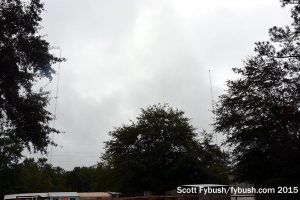
How about a few towers on this gray day?
WNRR (1380 North Augusta) is on Carolina Springs Road, a mile or so southeast of the WRDW-TV studios.
Head north on I-520 and you come to Augusta’s second-oldest station, WGAC (580). It’s a two-siter: this is the four-tower night site, and it’s a bit hard to photograph in its entirety. (The one-tower day site is out to the west of Augusta and we didn’t get there.)
Just across the river from North Augusta, the tower shared by WKZK (1600) and WYNF (1340) sits near Augusta’s minor-league ballpark, which is in turn just down the road from the famous Augusta National golf course.
The site for WRDW radio is along the river near here, too, though we missed it this day; the old WRDW 5 kW 1480 facility is gone now, replaced by an X-bander at 1630.

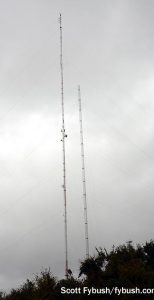
WRDW radio, WGAC and a big chunk of the Augusta FM dial are all part of the Beasley Broadcast Group now, operating from studios on the west side of town.
Those studios, in turn, aren’t far from the latest incarnation of “Television Park,” the name Augusta’s first TV station has long given to its studio home.
The original Television Park for WJBF-TV (Channel 6) was downtown, but it was replaced a few years ago by a new version out on Augusta West Parkway, built in a former Barnes and Noble store. (The old Television Park sign from downtown was saved and now faces out back so drivers on I-520 can see it.)
And here’s where things got really weird after we left. In addition to ABC affiliate WJBF, Media General was operating Schurz Communication’s NBC affiliate, WAGT (Channel 26), under a shared-services agreement from Television Park. Which was all well and good until Schurz sold its stations, including WAGT, to Gray Television – which owns WRDW-TV across town.
Gray had interesting plans for WAGT: it was going to shut down the full-power license, put it in the FCC’s upcoming spectrum auction, and then put NBC on a low-power station, WRDW-CD, that was going to take over WAGT’s current RF channel while not counting against ownership limits as the full-power WAGT would have.
In February, Gray took over WAGT and began simulcasting WRDW’s newscasts on it, but Media General went to court, alleging that Gray couldn’t cut off the existing SSA between WAGT and WJBF. Media General kept WAGT’s news staff working at Television Park, producing news for a rogue WAGT website – and then a week ago, a court upheld an injunction that returns WAGT’s operations to Media General and WJBF, at least for now and possibly for as long as the year 2020.
From Augusta we headed to Atlanta (which we’ll see next week), and from Atlanta we reworked our plans on the fly, heading inland instead of to the coast on our way home. That meant a night in Spartanburg, South Carolina – and that meant a chance to check in with our old friend Kirk Varner, who’d recently moved from Cincinnati’s WKRC-TV to Media General’s WSPA-TV (Channel 7) in Spartanburg, where he was settling in as news director.
WSPA’s building on International Drive, tucked in the woods just off business I-85, dates to the late 1970s, though it’s been modified over the years as WSPA’s radio stations moved out and a new sister TV station, WYCW (Channel 62), moved in. There’s a nice patio off the lobby where the station can do outdoor segments. And there’s a surprise upstairs: this building houses a hub for Media General’s CBS affiliates across the Southeast, a dozen or so in all including WBTW in Florence. (What will happen when Nexstar takes over from Media General?)
WSPA still has its own technical area here, of course. Its old analog production control room had recently been gutted and replaced by a new HD control room down the hall.
Newsrooms in this market have a huge area to cover: the “Greenville-Spartanburg-Asheville” market covers all of upstate South Carolina, a big mountainous chunk of western North Carolina and even some bits of northeast Georgia. WSPA maintains a studio in Greenville in addition to its Spartanburg headquarters; both it and Greenville competitor WYFF (Channel 4) tend to leave coverage of the North Carolina side of the market to ABC affiliate WLOS (Channel 13).
The WSPA studio is interesting: it’s open up top to a balcony lined with file tapes and to the windows of several top-floor offices. And note the logo in the photos above, which changed to a more modern “7” not long after we visited.
(We saw more of the Spartanburg and Greenville broadcast scene back in 2003; you can see that vintage Site of the Week installment here.)
Thanks to WSPA’s Kirk Varner for the tour!

As we announced a few weeks ago, the 2026 edition of the Tower Site Calendar will be the last.
We began publishing it 25 years ago, and the broadcast landscape is radically different now.
Radio World just ran an excellent article about us if you want to know more.
Once it’s gone, that’s it. We won’t be printing any more.
Thank you to everyone who saw our announcement and rushed to buy it. We appreciate you.
(There are some calendars from previous years if you want more of a tower photo fix — all under $5.)
But don’t wait to get this year’s Tower Site Calendar — buy it now!
We are selling the Broadcast Historian’s Calendar again this year, but we have that in an even smaller quantity — definitely don’t hesitate for that.
And visit the Fybush Media Store to check out our selection of books and videos, too!
And don’t miss a big batch of South Carolina IDs next Wednesday, over at our sister site, TopHour.com!
Next week: Atlanta, 2015
In this week’s issue… Veteran newsman returns - Remembering NY's Leitner, RI's Jones - CT AM saved - Maine AM moves - "Indie" adds suburban signals
In this week’s issue… Scripps stations face takeover - Sinclair moves more affiliations - CT stations sold - Maine AM surrendered - Remembering WVBR's Shapiro, WABC's Morgan
In this week’s issue… CT TV legend succumbs to cancer - Remembering PA's Adams - FCC still stalled by shutdown - Pittsburgh morning host exits
In this week’s issue… FCC faces reopening challenges - Veteran Boston anchor retires - Morning shift in Toronto - NYC FMs expand reach